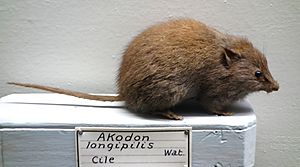Long-haired grass mouse facts for kids
Quick facts for kids Long-haired grass mouse |
|
|---|---|
 |
|
| Conservation status | |
| Scientific classification | |
| Genus: |
Abrothrix
|
| Species: |
longipilis
|
| Synonyms | |
|
|
The Abrothrix longipilis, also known as the long-haired grass mouse, is a small rodent. It belongs to the family Cricetidae, which includes many types of mice and hamsters. This mouse is native to central and southern Chile and parts of Argentina.
For a long time, scientists thought this mouse lived in a wider area. However, in 2014, they found that some populations in southern Chile and Argentine Patagonia are actually a very similar species called Abrothrix hirta. Another mouse, the southern Chilean Abrothrix sanborni, might also be the same species as the long-haired grass mouse.
Contents
What it Looks Like
The long-haired grass mouse is a strong and fairly large mouse. Its body, not including its tail, is about 130 mm (5 in) long. That's about the length of a smartphone!
Its fur color can be different depending on where it lives. Most of the time, the fur on its back is reddish-brown. It has longer, stiffer hairs mixed in. The fur on its sides is usually more grey. Its belly is grey. The tail has two colors: it's dark on top and lighter underneath.
Where it Lives and its Home
You can find the long-haired grass mouse in central and southern Chile. It also lives in Argentina, as far south as the Rio Negro and Chubut areas.
Its favorite place to live is in the Nothofagus forests. These are special types of beech forests found in South America. But these mice are adaptable! They can also live in rocky areas, wet marshy places, and even in grasslands with tall tussock grass and shrubs.
Daily Life and Habits
The long-haired grass mouse is busy both during the day and at night. It's very good at digging and makes its own burrows underground. But it's also a skilled tree climber!
What it Eats
The diet of the long-haired grass mouse changes depending on where it lives. In Argentina, it enjoys a varied diet. It eats berries, seeds, insects, slugs, worms, and even fungi. It also eats fern spores.
In different parts of Chile, its diet can be different. Sometimes it eats insects and plants. Other times, it might eat insects and fungi, or just insects, or even just fungi.
Reproduction and Life Cycle
Long-haired grass mice have their babies in the spring and summer months. On average, a mother mouse will have just under four babies in a litter. Some of these mice can live through two winters, which means they survive for more than a year.
Who Hunts the Mouse
Many animals hunt the long-haired grass mouse. These include different types of owls, like the barn owl, the lesser horned owl, and the rufous-legged owl. Birds of prey like the white-tailed kite also hunt them. On the ground, the South American gray fox is another predator.
Health and the Andes Virus
This mouse is also important because it can carry a germ called the Andes virus. This virus can cause a serious illness in people called Hantavirus cardiopulmonary syndrome. The mice themselves usually don't get sick, but they can pass the virus on.
Its Conservation Status
The Abrothrix longipilis lives in a large area and is thought to have a big population. While its numbers might be going down a little, it's still a very common species. The decline is not happening fast enough to be a major worry. Because of this, the International Union for Conservation of Nature (IUCN) says its conservation status is "least concern". This means it's not currently in danger of disappearing.
See also
 In Spanish: Ratón de pelo largo para niños
In Spanish: Ratón de pelo largo para niños


